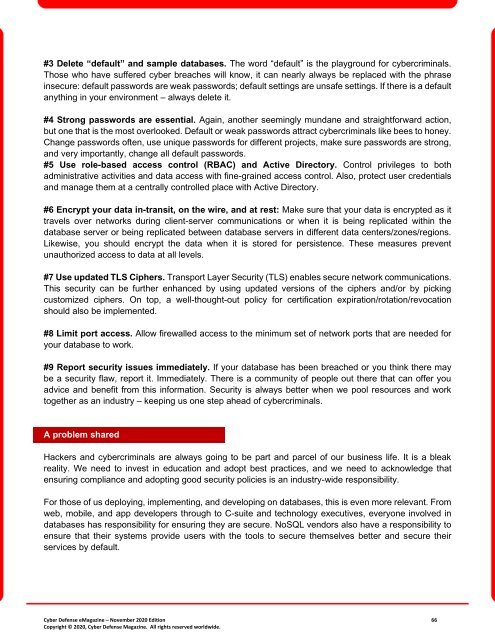Cyber Defense eMagazine November 2020 Edition
Cyber Defense eMagazine November Edition for 2020 #CDM #CYBERDEFENSEMAG @CyberDefenseMag by @Miliefsky a world-renowned cyber security expert and the Publisher of Cyber Defense Magazine as part of the Cyber Defense Media Group as well as Yan Ross, US Editor-in-Chief, Pieruligi Paganini, Co-founder & International Editor-in-Chief, Stevin Miliefsky, President and many more writers, partners and supporters who make this an awesome publication! Thank you all and to our readers! OSINT ROCKS! #CDM #CDMG #OSINT #CYBERSECURITY #INFOSEC #BEST #PRACTICES #TIPS #TECHNIQUES
Cyber Defense eMagazine November Edition for 2020 #CDM #CYBERDEFENSEMAG @CyberDefenseMag by @Miliefsky a world-renowned cyber security expert and the Publisher of Cyber Defense Magazine as part of the Cyber Defense Media Group as well as Yan Ross, US Editor-in-Chief, Pieruligi Paganini, Co-founder & International Editor-in-Chief, Stevin Miliefsky, President and many more writers, partners and supporters who make this an awesome publication! Thank you all and to our readers! OSINT ROCKS! #CDM #CDMG #OSINT #CYBERSECURITY #INFOSEC #BEST #PRACTICES #TIPS #TECHNIQUES
You also want an ePaper? Increase the reach of your titles
YUMPU automatically turns print PDFs into web optimized ePapers that Google loves.
#3 Delete “default” and sample databases. The word “default” is the playground for cybercriminals.<br />
Those who have suffered cyber breaches will know, it can nearly always be replaced with the phrase<br />
insecure: default passwords are weak passwords; default settings are unsafe settings. If there is a default<br />
anything in your environment – always delete it.<br />
#4 Strong passwords are essential. Again, another seemingly mundane and straightforward action,<br />
but one that is the most overlooked. Default or weak passwords attract cybercriminals like bees to honey.<br />
Change passwords often, use unique passwords for different projects, make sure passwords are strong,<br />
and very importantly, change all default passwords.<br />
#5 Use role-based access control (RBAC) and Active Directory. Control privileges to both<br />
administrative activities and data access with fine-grained access control. Also, protect user credentials<br />
and manage them at a centrally controlled place with Active Directory.<br />
#6 Encrypt your data in-transit, on the wire, and at rest: Make sure that your data is encrypted as it<br />
travels over networks during client-server communications or when it is being replicated within the<br />
database server or being replicated between database servers in different data centers/zones/regions.<br />
Likewise, you should encrypt the data when it is stored for persistence. These measures prevent<br />
unauthorized access to data at all levels.<br />
#7 Use updated TLS Ciphers. Transport Layer Security (TLS) enables secure network communications.<br />
This security can be further enhanced by using updated versions of the ciphers and/or by picking<br />
customized ciphers. On top, a well-thought-out policy for certification expiration/rotation/revocation<br />
should also be implemented.<br />
#8 Limit port access. Allow firewalled access to the minimum set of network ports that are needed for<br />
your database to work.<br />
#9 Report security issues immediately. If your database has been breached or you think there may<br />
be a security flaw, report it. Immediately. There is a community of people out there that can offer you<br />
advice and benefit from this information. Security is always better when we pool resources and work<br />
together as an industry – keeping us one step ahead of cybercriminals.<br />
A problem shared<br />
Hackers and cybercriminals are always going to be part and parcel of our business life. It is a bleak<br />
reality. We need to invest in education and adopt best practices, and we need to acknowledge that<br />
ensuring compliance and adopting good security policies is an industry-wide responsibility.<br />
For those of us deploying, implementing, and developing on databases, this is even more relevant. From<br />
web, mobile, and app developers through to C-suite and technology executives, everyone involved in<br />
databases has responsibility for ensuring they are secure. NoSQL vendors also have a responsibility to<br />
ensure that their systems provide users with the tools to secure themselves better and secure their<br />
services by default.<br />
<strong>Cyber</strong> <strong>Defense</strong> <strong>eMagazine</strong> – <strong>November</strong> <strong>2020</strong> <strong>Edition</strong> 66<br />
Copyright © <strong>2020</strong>, <strong>Cyber</strong> <strong>Defense</strong> Magazine. All rights reserved worldwide.


















